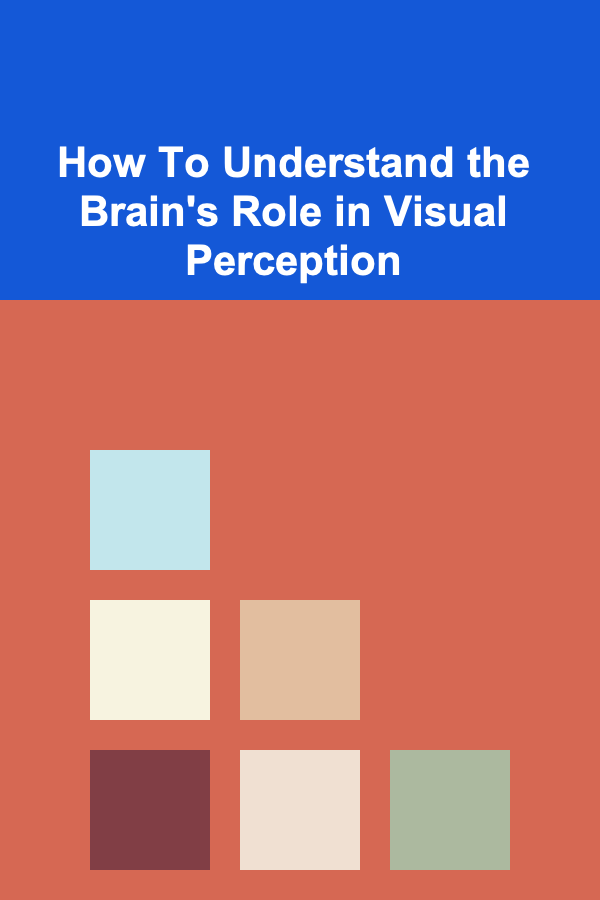
How To Understand the Brain's Role in Visual Perception
ebook include PDF & Audio bundle (Micro Guide)
$12.99$6.99
Limited Time Offer! Order within the next:

Visual perception is one of the most complex and essential aspects of how humans interact with the world around them. It encompasses the processes by which the brain interprets visual information from the environment, helping individuals navigate, recognize objects, and respond to various stimuli. Understanding the brain's role in visual perception is crucial for fields such as neuroscience, psychology, artificial intelligence, and even design.
This article delves into the intricacies of how the brain processes visual stimuli, explaining the key concepts, mechanisms, and brain regions involved. It explores the anatomy and physiology of the visual system, the cognitive processes behind visual interpretation, and the factors that influence how we perceive the world visually.
The Visual System: Anatomy and Function
To understand how the brain interprets visual information, it's essential to first grasp the basic anatomy of the visual system. The visual system consists of the eyes, the optic nerves, the pathways to the brain, and the brain regions responsible for processing visual input. Here, we break down the journey of visual stimuli from the external world to brain processing.
1. The Eye: The Gateway to Visual Information
The journey of visual information begins in the eyes, where light enters through the cornea, passes through the pupil, and is focused by the lens onto the retina at the back of the eye. The retina is a critical structure, as it contains specialized cells that detect light and convert it into electrical signals.
- Rod Cells: These cells are sensitive to dim light and play a key role in low-light vision (scotopic vision).
- Cone Cells: These cells are responsible for color vision and function best in bright light (photopic vision).
Once the photoreceptor cells in the retina detect light, they send electrical signals to the brain through the optic nerve.
2. The Optic Nerve and Visual Pathways
The optic nerve carries the visual information from the retina to the brain. The pathway diverges in the optic chiasm, where signals from the left and right eyes cross and travel to the opposite side of the brain. From there, the signals are transmitted along the optic tract to various brain regions for further processing.
3. The Visual Cortex: The Brain's Interpretation Hub
The primary area of the brain responsible for visual processing is the occipital lobe , specifically the visual cortex, located at the back of the brain. The visual cortex is organized into several areas, each responsible for different aspects of visual perception:
- V1 (Primary Visual Cortex): The first processing area where basic features like edges, orientations, and contrast are detected.
- V2 and V3: These areas process more complex visual information, such as shapes, depth, and motion.
- V4: Responsible for color perception.
- MT (Middle Temporal Area): Plays a key role in processing motion and visual tracking.
Together, these areas allow the brain to combine the raw data from the eyes into a cohesive visual representation of the world.
The Cognitive Mechanisms Behind Visual Perception
While the anatomy of the visual system explains how visual information is transmitted, cognitive processes are responsible for interpreting and making sense of that information. Visual perception involves not only detecting raw stimuli but also integrating sensory data, making predictions, and forming mental representations. Here are some of the key cognitive mechanisms involved:
1. Top-Down and Bottom-Up Processing
Visual perception relies on two primary types of processing:
- Bottom-Up Processing: This is data-driven and refers to the way the brain starts with the sensory input and gradually builds up a perception from the ground up. For example, when looking at a new object, the brain analyzes raw features such as color, shape, and texture before identifying the object as a whole.
- Top-Down Processing: This is driven by prior knowledge, expectations, and experiences. The brain uses context, memory, and expectations to interpret visual stimuli. For instance, when recognizing a familiar face, the brain doesn't just rely on raw sensory data but also draws on stored information about what the face looks like.
2. Object Recognition and Theories of Perception
The brain uses several theories to process and recognize objects. One of the most influential theories is the feature integration theory , which posits that the brain first processes basic features (such as color and shape) and then combines them to form a perception of the whole object. Another theory, recognition-by-components, suggests that objects are broken down into simpler components (like basic shapes or edges) that are then recognized and reconstructed by the brain.
3. Depth Perception and Visual Cues
Depth perception refers to the ability to perceive the three-dimensional structure of the world. The brain uses several visual cues to interpret depth:
- Binocular Cues : These include stereopsis, which relies on the slight difference between the images from each eye (binocular disparity). This difference allows the brain to perceive depth and distance.
- Monocular Cues : These include cues such as perspective , texture gradients , and relative size. Monocular cues help the brain perceive depth even with one eye closed.
4. Motion Perception
The perception of motion is another critical aspect of visual processing. The brain uses the MT (middle temporal area) to detect changes in the position of objects over time. Several visual mechanisms contribute to motion perception, including aperture effects, where objects moving through a small visual field can appear to move in different directions based on the context of their surroundings.
Visual Illusions and the Brain
Visual illusions offer valuable insights into how the brain processes visual information. They occur when the brain interprets visual stimuli in ways that do not accurately reflect reality. These illusions highlight the brain's reliance on expectations, context, and prior knowledge to interpret the world.
Some common types of visual illusions include:
- Size Constancy: The brain perceives an object as being the same size despite changes in distance. For example, a car at a distance looks smaller, but we still perceive it as the same size.
- Color Perception: Lighting conditions can alter how colors appear to the brain, leading to illusions like the famous "dress" phenomenon.
- Motion Aftereffects: After staring at a moving object for a period of time, stationary objects may appear to move in the opposite direction, illustrating how the brain adapts to movement.
Brain Regions Involved in Visual Perception
The brain regions involved in visual perception are not limited to the occipital lobe. Visual processing is a highly integrated system that engages several other regions of the brain, including those responsible for memory, attention, and higher cognitive functions.
1. Parietal Lobe: Spatial Awareness
The parietal lobe plays a critical role in integrating visual information with spatial awareness. This is essential for guiding movement and interaction with objects in the environment. The parietal lobe is involved in visual-spatial processing, helping us understand where objects are in relation to ourselves.
2. Temporal Lobe: Object Recognition and Memory
The temporal lobe is involved in identifying and categorizing objects. It contains the fusiform face area (FFA), which is specifically involved in face recognition. The temporal lobe also plays a significant role in associating visual stimuli with past experiences and memory, facilitating the recognition of familiar objects and faces.
3. Frontal Lobe: Decision-Making and Visual Attention
The frontal lobe is involved in higher cognitive functions such as decision-making, attention, and motor control. In the context of visual perception, the frontal lobe helps direct attention to important visual stimuli, allowing us to focus on specific objects or aspects of the visual field while ignoring irrelevant details.
Factors Influencing Visual Perception
While the brain plays a dominant role in visual perception, several external and internal factors can influence how we perceive the world. These factors include:
1. Attention
Attention plays a critical role in visual perception. The brain filters out irrelevant information and focuses on specific stimuli. For instance, when driving, the brain attends to road signs, pedestrians, and other vehicles while disregarding background elements. This selective attention influences how we interpret and prioritize visual information.
2. Experience and Expectations
Our past experiences and expectations heavily influence visual perception. For example, a person who has seen many cars before is likely to recognize a new car quickly, while someone unfamiliar with cars may struggle. Similarly, cultural differences can shape visual interpretation, as people from different cultures may perceive the same visual stimuli differently.
3. Visual Pathologies
Certain visual disorders and pathologies, such as color blindness , prosopagnosia (face blindness), and visual agnosia, provide valuable insight into how the brain processes visual information. These conditions illustrate how specific brain regions or pathways are involved in visual perception, and how damage or dysfunction in these areas can affect the interpretation of visual stimuli.
Conclusion
The brain's role in visual perception is a complex and dynamic process involving multiple interconnected regions, pathways, and cognitive mechanisms. From the initial detection of light by the eyes to the complex interpretation of visual information in the brain, visual perception allows us to navigate and make sense of the world. Understanding how the brain processes visual stimuli is not only fundamental for neuroscience but also has profound implications for fields such as psychology, design, and artificial intelligence.
By studying the visual system and its intricacies, we gain a deeper understanding of how the brain creates our visual reality, helping to unlock mysteries about perception, cognition, and human experience. As research advances, it continues to shed light on the sophisticated neural processes that allow us to see and understand the world around us.
Reading More From Our Other Websites
- [Organization Tip 101] How to Create a Charity Challenge to Inspire Donations
- [Home Rental Property 101] How to Write a Lease Agreement That Protects You and Your Property
- [Stamp Making Tip 101] Best Eco‑Friendly Materials for Handmade Rubber Stamp Crafting
- [Home Renovating 101] How to Select the Perfect Shower Tile Trends for a Spa-like Bathroom Renovation
- [Screen Printing Tip 101] DIY vs. Professional Frames: Which Screen Printing Frame is Right for You?
- [Personal Investment 101] How to Use Silver ETFs to Diversify Your Investment Portfolio
- [Home Soundproofing 101] How to Enhance Soundproofing with Green Materials
- [Personal Financial Planning 101] How to Reduce Financial Risk in a Volatile Market
- [Personal Care Tips 101] How to Use Body Butter to Treat Dry, Cracked Skin on Hands and Feet
- [Home Rental Property 101] How to Create a Desirable Pet-Friendly Rentals Policy That Protects Your Property

How to Declutter Your Home Effectively Before Staging
Read More
How to Maintain Your Roof to Avoid Costly Repairs
Read More
How to Understand Blockchain for Secure Data Sharing
Read More
How to Use Pinterest Effectively for Wedding Inspiration
Read More
The Psychology of Success: Key Traits and Behaviors of Successful People
Read More
How To Install a New Mailbox: A Comprehensive Guide
Read MoreOther Products

How to Declutter Your Home Effectively Before Staging
Read More
How to Maintain Your Roof to Avoid Costly Repairs
Read More
How to Understand Blockchain for Secure Data Sharing
Read More
How to Use Pinterest Effectively for Wedding Inspiration
Read More
The Psychology of Success: Key Traits and Behaviors of Successful People
Read More